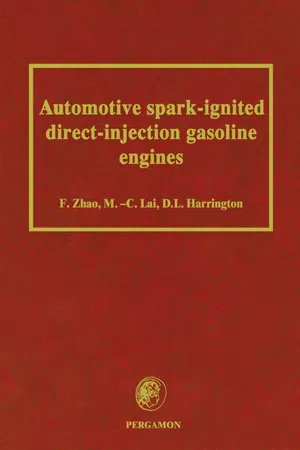
Automotive Spark-Ignited Direct-Injection Gasoline Engines
- 128 pages
- English
- ePUB (mobile friendly)
- Available on iOS & Android
Automotive Spark-Ignited Direct-Injection Gasoline Engines
About This Book
The process of fuel injection, spray atomization and vaporization, charge cooling, mixture preparation and the control of in-cylinder air motion are all being actively researched and this work is reviewed in detail and analyzed.
The new technologies such as high-pressure, common-rail, gasoline injection systems and swirl-atomizing gasoline fuel injections are discussed in detail, as these technologies, along with computer control capabilities, have enabled the current new examination of an old objective; the direct-injection, stratified-charge (DISC), gasoline engine. The prior work on DISC engines that is relevant to current GDI engine development is also reviewed and discussed.
The fuel economy and emission data for actual engine configurations have been obtained and assembled for all of the available GDI literature, and are reviewed and discussed in detail. The types of GDI engines are arranged in four classifications of decreasing complexity, and the advantages and disadvantages of each class are noted and explained. Emphasis is placed upon consensus trends and conclusions that are evident when taken as a whole; thus the GDI researcher is informed regarding the degree to which engine volumetric efficiency and compression ratio can be increased under optimized conditions, and as to the extent to which unburned hydrocarbon (UBHC), NO x and particulate emissions can be minimized for specific combustion strategies. The critical area of GDI fuel injector deposits and the associated effect on spray geometry and engine performance degradation are reviewed, and important system guidelines for minimizing deposition rates and deposit effects are presented. The capabilities and limitations of emission control techniques and after treatment hardware are reviewed in depth, and a compilation and discussion of areas of consensus on attaining European, Japanese and North American emission standards presented.
All known research, prototype and production GDI engines worldwide are reviewed as to performance, emissions and fuel economy advantages, and for areas requiring further development. The engine schematics, control diagrams and specifications are compiled, and the emission control strategies are illustrated and discussed. The influence of lean-NO x catalysts on the development of late-injection, stratified-charge GDI engines is reviewed, and the relative merits of lean-burn, homogeneous, direct-injection engines as an option requiring less control complexity are analyzed.
Frequently asked questions
Information
Automotive spark-ignited direct-injection gasoline engines
Table of contents
- Cover image
- Title page
- Table of Contents
- Copyright
- Chapter 1: Automotive spark-ignited direct-injection gasoline engines
- This page is intentionally left blank